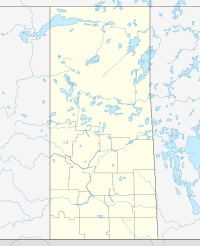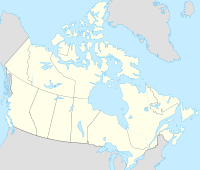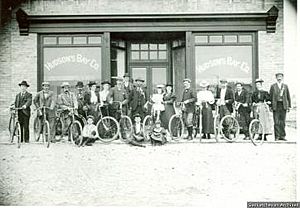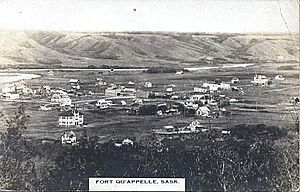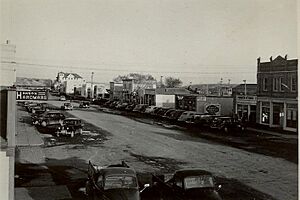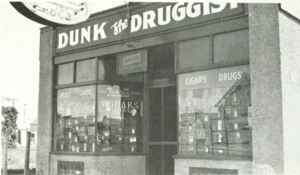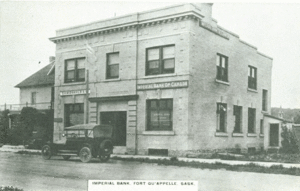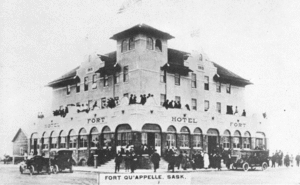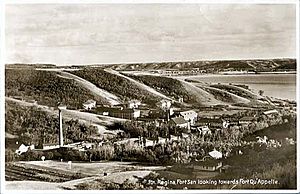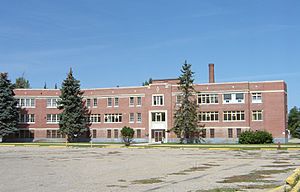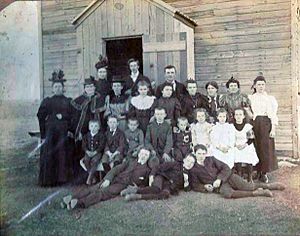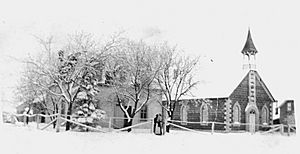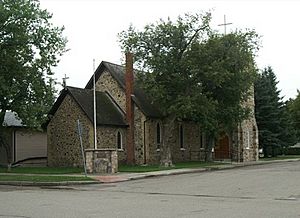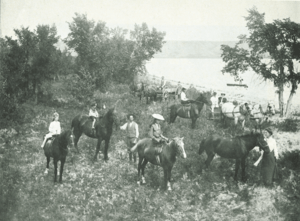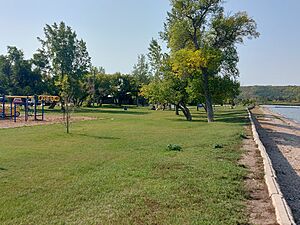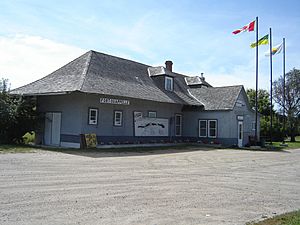Fort Qu'Appelle facts for kids
Quick facts for kids
Fort Qu'Appelle
|
|
|---|---|
|
Town
|
|
| Town of Fort Qu'Appelle | |
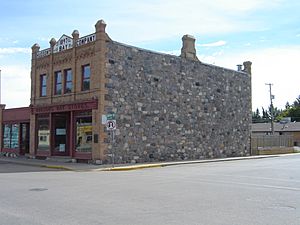
1897 Hudson's Bay Company store in Fort Qu'Appelle, Saskatchewan
|
|
| Nickname(s):
"the Fort"
|
|
| Country | Canada |
| Province | Saskatchewan |
| Rural Municipality | North Qu'Appelle |
| Post office Founded | 1880 |
| Incorporated (town) | 1951 |
| Area | |
| • Total | 5.28 km2 (2.04 sq mi) |
| Population
(2006)
|
|
| • Total | 1,919 |
| • Density | 363.2/km2 (941/sq mi) |
| Time zone | CST |
| Postal code |
S0G 1S0
|
| Area code(s) | 306 |
| Waterways | Qu'Appelle River |
| Website | Fort Qu'Appelle, Saskatchewan |
| Official name: Fort Qu'Appelle National Historic Site of Canada | |
| Designated: | 1953 |
Fort Qu'Appelle is a town in the Canadian province of Saskatchewan. It is located in the Qu'Appelle River valley, about 70 km northeast of Regina. The town sits between Echo Lake and Mission Lake, which are part of the Fishing Lakes.
Fort Qu'Appelle started as a Hudson's Bay Company trading post in 1864. In 2006, about 1,919 people lived there. The town is a meeting point for several highways, including Highway 35 and Highway 10. Important landmarks include the old Hudson's Bay Company store from 1897 and the Treaty 4 Governance Centre, which looks like a teepee. There is also a statue of a praying man by Noel Pinay, honoring a burial ground.
Contents
- What is the History of Fort Qu'Appelle?
- How Many People Live in Fort Qu'Appelle?
- How Has Fort Qu'Appelle Developed?
- Medical and Health Facilities
- Education in Fort Qu'Appelle
- Places of Worship
- What is the Climate Like in Fort Qu'Appelle?
- Sports in Fort Qu'Appelle
- Recreation and Tourism
- Famous People from Fort Qu'Appelle
- Media and Entertainment
- Images for kids
- See also
What is the History of Fort Qu'Appelle?
The town of Fort Qu'Appelle has a long history, with its name used for different trading posts over time. The first post with this name was a North West Company trading post from 1801 to 1805. It was located closer to what is now the Saskatchewan-Manitoba border. The Hudson's Bay Company also used the name for a post near Whitewood from 1813 to 1819.
The site where the town is now became important in the mid-1800s. It was a hub for many old trails that crossed the northwest. The Hudson's Bay Company had a post here from 1852 to 1854. An Anglican mission was also set up, which is still the town's St. John the Evangelist Anglican church today.
The trading post was active again from 1864 to 1911. After Treaty 4 was signed by Cree and Saulteaux peoples at Fort Qu'Appelle, the North-West Mounted Police (now the Royal Canadian Mounted Police or RCMP) arrived. They have been in the town ever since.
How Did Farming Change Fort Qu'Appelle?
Fort Qu'Appelle changed a lot when farming began in the 1880s. Farmers needed a nearby town to sell their crops and buy supplies. They also needed a place to gather socially. Over time, farms became larger, and fewer people lived on them. Many farmers started to retire and move into Fort Qu'Appelle, especially from the 1970s onwards.
The name "Qu'Appelle" comes from a French phrase meaning 'who calls'. This comes from its Cree name, kâ-têpwêt, which means 'river that calls'. A popular legend tells of two lovers, which is why the river got its name.
The town is right next to where the original 1864 Hudson's Bay Company trading post was. This old "factory" building is now a historical site and museum. It shows how the company traded furs with First Nations people.
The Hudson's Bay Company store on Broadway Street opened in 1897. By then, the fur trade was less important, but the town had grown with more residents and farmers coming to shop. The store building is still there, though it is no longer used by The Bay.
For a while, there was confusion about whether this town or another nearby town should be called "Qu'Appelle." In 1911, they agreed that the town in the valley would be Fort Qu'Appelle. Fort Qu'Appelle also tried to become the capital of the Northwest Territories, but Regina was chosen in 1882.
The name Fort Qu'Appelle was used for several trading posts in the valley. The Hudson's Bay Company had a post south of McLean, Saskatchewan from 1855 to 1864, mainly for pemmican. In 1864, it moved to the current site of Fort Qu'Appelle.
In 1883, three industrial boarding schools for First Nations teenagers were built. One was on the south side of Mission Lake, across from Lebret. The site of the fort was recognized as a National Historic Site of Canada in 1953.
How Many People Live in Fort Qu'Appelle?
In the 2021 Census, Fort Qu'Appelle had a population of 1,972 people. They lived in 850 homes out of 936 total private homes. This was a small decrease of 3.4% from its 2016 population of 2,042. The town covers an area of 5.09 square kilometers. This means there were about 387.2 people per square kilometer in 2021.
| Canada census – Fort Qu'Appelle community profile | |||
|---|---|---|---|
| 2016 | 2011 | 2006 | |
| Population: | 1,920 (−5.6% from 2011) | 2,034 (6.0% from 2006) | 1,919 (−1.1% from 2001) |
| Land area: | 2.14 km2 (0.83 sq mi) | 5.28 km2 (2.04 sq mi) | 5.28 km2 (2.04 sq mi) |
| Population density: | 898.9/km2 (2,328/sq mi) | 385.0/km2 (997/sq mi) | 363.2/km2 (941/sq mi) |
| Median age: | 44.7 (M: 42.6, F: 46.5) | 48.0 (M: 45.2, F: 50.5) | 45.1 (M: 41.6, F: 47.1) |
| Total private dwellings: | 906 | 926 | 815 |
| Median household income: | $N/A | $N/A | $48,116 |
| References: 2016 2011 2006 earlier | |||
How Has Fort Qu'Appelle Developed?
Fort Qu'Appelle grew a lot in the 1880s and 1890s. This was when European settlers, mostly farmers, started arriving in the area. A post office opened in 1880. The town also became a center for the North-West Mounted Police.
Many older homes and shops, along with the town's Anglican and United churches, show its 19th-century British influence. In 1913, a fish culture station began construction near the town. This facility has provided billions of fish to stock lakes across the province. The Fort Qu'Appelle Sanatorium (Fort San), a hospital for tuberculosis patients, opened in 1917.
The town's shops were very busy, serving many local farms. The Fort Hotel had a popular pub. There was also a large drive-in movie theater, which was popular until the 1960s when home television became common.
Even as the number of people living on farms decreased after World War II, Fort Qu'Appelle continued to grow. It became a popular place for people with summer cottages around the Qu'Appelle Lakes. People from Regina and other towns used Fort Qu'Appelle as a base for their lake activities. They bought supplies and services there.
In the early 1960s, a new highway, Highway 10, made it much easier and faster to reach Fort Qu'Appelle. This helped the town grow even more. In 1963, rural schools closed, and children from farms started taking buses to schools in town. This further helped Fort Qu'Appelle become a central hub. Today, the town is a main shopping and service center for farmers, people living in nearby resort villages, and summer visitors.
Medical and Health Facilities
Maurice Macdonald Seymour, a doctor, helped create the Saskatchewan Anti-Tuberculosis League. This group built the Fort Qu'Appelle sanitarium, a hospital for tuberculosis patients. It opened in 1917 at nearby Fort San. When tuberculosis was no longer a major health problem, the building became an arts complex. It hosted a large summer program from 1967 to 1991. Now, it is a resort village and conference center.
The former Fort Qu'Appelle Indian Hospital was replaced in 2004 by the All Nations Healing Hospital. This hospital is special because it is one of the first health care facilities in Canada owned and run by First Nations governments. Sixteen First Nations governments work together to operate it.
Education in Fort Qu'Appelle
Fort Qu'Appelle has two main schools:
- Bert Fox Community High School for older students.
- Fort Qu'Appelle Elementary Community School for younger students.
The old Central School, built in 1911, is now the Qu'Appelle Valley Centre for the Arts. Parklands College is located at the Treaty 4 Governance Centre. Schooling in Fort Qu'Appelle changed a lot in 1963. Many small rural schools closed, and students from farms began to be bused to schools in Fort Qu'Appelle.
From 1967 to 1991, the former tuberculosis hospital at Fort San became the Saskatchewan Summer School of the Arts. It offered programs in dance, music, art, writing, and theater. This brought many summer visitors to Fort San and Fort Qu'Appelle.
Places of Worship
Several churches with long histories are found in and around Fort Qu'Appelle:
- The Sacred Heart Roman Catholic Church in nearby Lebret.
- St. John the Evangelist Anglican Church, which continues the tradition of an 1854 mission.
- St. Andrew's United Church, which was Presbyterian until 1925.
Newer churches include Our Lady of Sorrows Roman Catholic Church, Our Saviour Lutheran Church, Valley Alliance Church, and the Kingdom Hall of Jehovah's Witnesses.
What is the Climate Like in Fort Qu'Appelle?
Fort Qu'Appelle has a semi-arid continental climate. This means it has dry winters and cool summers. Winters can be very cold, but warm, dry Chinook winds sometimes blow in from the Pacific Ocean. These winds can make the temperature rise quickly, sometimes by as much as 15 degrees Celsius in just a few hours.
Fort Qu'Appelle experiences extreme temperatures. The coldest temperature ever recorded was -47.2 degrees Celsius in January 1916. The hottest was 44.4 degrees Celsius in July 1937. The closest weather station is in Qu'Appelle, about 27 km away. The average temperature in Qu'Appelle ranges from -14.2 degrees Celsius in January to 18.5 degrees Celsius in July.
Because it is a dry area, summer evenings in Fort Qu'Appelle can be very cool. The average summer low temperature drops to 10.6 degrees Celsius.
Fort Qu'Appelle gets about 455.4 mm of precipitation each year. Most of this is rain (342.5 mm), and the rest is snow (113.0 cm). Most rain falls from May to August. Droughts can happen at any time of year and sometimes last for months.
| Climate data for Fort Qu'Appelle, 1981–2010 normals, extremes 1912–1972 | |||||||||||||
|---|---|---|---|---|---|---|---|---|---|---|---|---|---|
| Month | Jan | Feb | Mar | Apr | May | Jun | Jul | Aug | Sep | Oct | Nov | Dec | Year |
| Record high °C (°F) | 11.1 (52.0) |
13.3 (55.9) |
22.8 (73.0) |
33.3 (91.9) |
37.8 (100.0) |
42.2 (108.0) |
44.4 (111.9) |
41.1 (106.0) |
36.7 (98.1) |
32.8 (91.0) |
21.7 (71.1) |
16.1 (61.0) |
44.4 (111.9) |
| Mean daily maximum °C (°F) | −9.4 (15.1) |
−6.7 (19.9) |
-0.0 (32.0) |
11.0 (51.8) |
17.7 (63.9) |
21.7 (71.1) |
25.0 (77.0) |
24.5 (76.1) |
18.2 (64.8) |
10.1 (50.2) |
−0.8 (30.6) |
−7.5 (18.5) |
8.7 (47.7) |
| Daily mean °C (°F) | −14.2 (6.4) |
−11.4 (11.5) |
−4.9 (23.2) |
4.6 (40.3) |
11.0 (51.8) |
15.6 (60.1) |
18.5 (65.3) |
17.7 (63.9) |
11.8 (53.2) |
4.5 (40.1) |
−5.1 (22.8) |
−12.0 (10.4) |
3.0 (37.4) |
| Mean daily minimum °C (°F) | −18.9 (−2.0) |
−16.1 (3.0) |
−9.8 (14.4) |
−1.9 (28.6) |
4.3 (39.7) |
9.5 (49.1) |
12.0 (53.6) |
10.9 (51.6) |
5.3 (41.5) |
−1.2 (29.8) |
−9.4 (15.1) |
−16.4 (2.5) |
−2.7 (27.1) |
| Record low °C (°F) | −47.2 (−53.0) |
−46.7 (−52.1) |
−40.6 (−41.1) |
−27.8 (−18.0) |
−12.8 (9.0) |
−4.4 (24.1) |
−2.2 (28.0) |
−2.8 (27.0) |
−13.3 (8.1) |
−25.0 (−13.0) |
−37.2 (−35.0) |
−42.8 (−45.0) |
−47.2 (−53.0) |
| Average precipitation mm (inches) | 15.6 (0.61) |
11.5 (0.45) |
23.1 (0.91) |
26.9 (1.06) |
60.6 (2.39) |
83.2 (3.28) |
74.7 (2.94) |
57.8 (2.28) |
38.2 (1.50) |
26.4 (1.04) |
18.0 (0.71) |
19.5 (0.77) |
455.4 (17.93) |
| Average rainfall mm (inches) | 0.5 (0.02) |
0.5 (0.02) |
3.8 (0.15) |
14.8 (0.58) |
52.0 (2.05) |
82.9 (3.26) |
74.7 (2.94) |
57.8 (2.28) |
35.5 (1.40) |
17.5 (0.69) |
1.8 (0.07) |
0.6 (0.02) |
342.5 (13.48) |
| Average snowfall cm (inches) | 15.1 (5.9) |
11.0 (4.3) |
19.4 (7.6) |
12.1 (4.8) |
8.6 (3.4) |
0.2 (0.1) |
0.0 (0.0) |
0.0 (0.0) |
2.7 (1.1) |
8.9 (3.5) |
16.2 (6.4) |
18.9 (7.4) |
113.0 (44.5) |
| Source: Environment Canada | |||||||||||||
Sports in Fort Qu'Appelle
The Mission Ridge Ski Hill is located just south of town. It is open in winter for skiing and snowboarding. In July, Mission Ridge hosts "Rockin' the Ridge," a music festival.
Fort Qu'Appelle has a strong history in hockey. In 2007, the town hosted the Keystone Cup, a Junior "B" ice hockey championship. The local team, Fort Knox, won the silver medal. The Fort Qu'Appelle Falcons, a midget-level team, finished first in their league in 2008–2009. Other teams like the Fort Qu'Appelle Flyers have won provincial championships. Glen Burdon, a hockey player who started with the Fort Qu'Appelle Silver Foxes, was drafted into both the National Hockey League and the World Hockey Association.
The Fort Qu'Appelle curling club started in 1894. The town also had a baseball team, the Fort Qu'Appelle Sioux Indians.
Recreation and Tourism
Fort Qu'Appelle and the nearby Qu'Appelle Valley are popular places for recreation and tourism. People have been building cottages on the lakes since before World War I. The lakes are great for swimming, boating, and fishing in summer. In winter, people enjoy cross-country skiing, snowmobiling, and ice fishing.
Echo Valley Provincial Park is located between Echo Lake and Pasqua Lake. It offers RV parks, camping, swimming, boating, and fishing.
The old Fort Qu'Appelle station was built by the Grand Trunk Pacific Railway. Passenger train service stopped in 1978, but the station is still there. It is now used as a visitor center.
A major event is the Treaty 4 Gathering, a week-long celebration of the signing of Treaty 4. It happens in September, around the 15th, with daily Pow wows.
Famous People from Fort Qu'Appelle
- Walter Dieter: He was the first chief of the National Indian Brotherhood, which is now called the Assembly of First Nations.
- James Henderson: A well-known artist from Saskatchewan who worked in Fort Qu'Appelle for many years.
- Mel "Sudden Death" Hill: A forward in the National Hockey League.
- Eddie Shore: A famous hockey star and member of the Hockey Hall of Fame, born in Fort Qu'Appelle.
- Noel Starblanket: The third chief of the National Indian Brotherhood.
Media and Entertainment
- Fort Qu'Appelle Times: The town's weekly newspaper.
- Television: The town has re-transmitters for CBC (channel 4), Global (channel 6), and CTV (channel 7).
Movies and TV Shows Filmed Here
Fort Qu'Appelle has been a filming location for several productions:
- The movie Skipped Parts filmed scenes in Fort Qu'Appelle and nearby towns.
- The CBC movie Betrayed was mostly filmed in Fort Qu'Appelle, including scenes at the old hospital.
- The television series Life Without Borders is filmed and produced in the Fort Qu'Appelle area.
Images for kids
-
Troops on the march during the North-West Rebellion in the Qu'Appelle Valley, 1885.
See also
- List of towns in Saskatchewan


